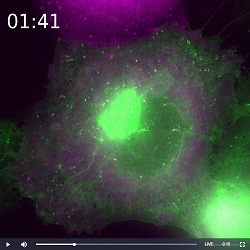
The secretory pathway is a fundamental component of normal cellular function, but there is still much to discover about its precise mechanisms. CIMR’s Gershlick lab studies the dynamics and drivers of protein cargo trafficking from the Golgi network to the plasma membrane by integrating the Retention Using Selective Hooks (RUSH) system with a quantitative, fluorescent reporting technique which they have pioneered. Publishing in the Journal of Cell Biology, Dr Conceição Pereira, Dr Danièle Stalder and colleagues use RUSH to demonstrate an essential role for the exocyst protein complex in tethering post-Golgi cargo vesicles at the plasma membrane prior to secretion. The wider applicability of this finding was supported by data produced in collaboration with Cambridge colleagues Dr Daniel Fazakerley (Institute of Metabolic Sciences) and Dr Michael Chapman (MRC Toxicology Institute), which showed respective, essential roles of the exocyst complex in the constitutive secretion of hormones from adipocytes and of antibodies from myeloma plasma cells.

